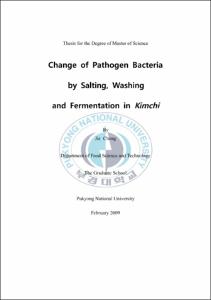Change of Pathogen Bacteria by Salting, Washing and Fermentation in Kimchi
- Abstract
- 김치는 전통적인 한국 발효 음식으로써 국제적 식품으로 발전하고 있지만 현대 사회에서 식품안전은 이미 불가피한 과제이가 되고있다. 김치는 살균과정이 없는 제품으로서 염장, 세척방법, 발효과정 시 유해미생물을 조절할 수 밖에 없다. 따라서, 이런 김치제조공정 중 제조조건에 따라 유해미생물에 미치는 영향을 조사하기위하여 4절배추를 대상으로 실험하였으며. 생 배추와 절인 배추에 각각 식중독 미생물인 Escherichia coli KCTC 1682, Staphylococcus aureus KCTC 1927 그리고 Salmonella typhimurium KCTC 1925을 인위적으로 접종하여 절임, 세척, 발효과정 중 유해미생물에 미치는 영향을 조사하였다.
4가지농도의 소금물(8%, 10%, 12%, 15%)로 절임실험을 진행한 결과, Salmonella typhimurium KCTC 1925는 소금물에 매우 민감하기 때문에 5시간만의 절임 후 4가지 소금물농도 모두에서 Salmonella typhimurium을 검측해낼 수 없었다. 이와 반대로, Escherichia coli와 Staphylococcus aureus는 NaCl에 아주 강한 저항성을 가지고 있어 15시간의 절임시간 후에도 선명하게 감소함을 관찰할 수 없었으며 8%, 10%, 12%, 15%의 소금물은 각각 Escherichia coli의 량을 4.40×10^(6) cfu/g으로부터 5.20×10^(5),1.64×10^(5),2.92×10^(5) ,1.98×10^(5) cfu/g로 감소되게 하였다. 또한, 8%,10%,12%,15% 소금물은 Staphylococcus aureus의 량을 2.02×10^(6) cfu/g으로부터 각각 1.9×10⁴ cfu/g,4.1×10³,1.48×10³,6.65×10⁴ cfu/g로 감소하게 하였다.
10% 소금물에 15시간 절인 후 네 가지 세척방법 (2회 물세척, 3회 물세척, sodium dichlroisocyanurate (NaDCC)로 3회 세척, 3%초산으로 3회 세척)으로 4절배추를 세척하였다. Staphylococcus aureus는 4 가지 세척방법으로 완전히 제거할 수 있으나 NaDCC와 초산으로의 3회 세척하여 더 좋은 제거 효과를 얻었으며, Escherichia coli는 절임배추에서 발견되지 않음을 확인하였다. 발효실험에서 Escherichia coli는 pH값이 3.63이고 산도가 1.16%에 도달했을 때 김치에서 발견되지 않았으며 이와 다르게 Staphylococcus aureus는 갓 숙성되기 시작하였을 때 완전히 억제되었으며 pH값이 4.14보다 작고 산도가 0.73%에 도달하였을 때 김치에서 검출해내지 못하였다. Staphylococcus aureus와 비슷하게 Salmonella typhimurium도 pH값과 산도가 각각 4.09와 0.77%에 도달하였을 때 김치에서 발견할 수가 없었다. 김치 숙성과정에서 Escherichia coli가 제일 높은 산 저항능력이 있음을 확인하였고, 유해 미생물의 감소와 함께 유산균은 증가함을 확인 할 수 있었다.
Kimchi is a traditional, fermented Korean food, and gradually becomes a cosmopolitan food. In modern society, food safety has become an unevadable issue. In this paper, in order to determine the changes of foodborne bacteria by salting, washing and fermentation in kimchi, three kinds of food-borne bacteria including Escherichia coli KCTC 1682, Staphylococcus aureus KCTC 1927, and Salmonella typhimurium KCTC 1925 were inoculated into raw cabbages and salted cabbages, respectively.
For salting trials, four kinds of brine (8%, 10%,12%,and 15%) were used to salt cabbages, the amount of Escherichia coli and Staphylococcus aureus weren't decreased obviously after 15h salting in all the four kinds of brine, by contrast, Salmonella typhimurium, which was very sensitive to brine, couldn't be detectable only after 5h salting in all the four kinds of brine.
For washing trials, After 15h of soaking in 10% brine, four kinds of washing method(ie. water 2 strokes, water 3 strokes, sodium dichlroisocyanurate (NaDCC) 3 stokes, and acetic acid 3 strokes) were used to wash salted cabbages. Though Staphylococcus aureus and Escherichia coli couldn't be eliminated entirely by any of the four kinds of washing methods, compared the four methods, NaDCC and acetic acid 3 strokes were more effectively to eliminate Staphylococcus aureus and Escherichia coli.
For fermentation trials, In the process of fermentation, when pH 3.63 and acidity 1.16% have been reached, Escherichia coli was undetectable in kimchi. Differently, from just beginning of ripening, the growth of Staphylococcus aureus was inhibited, when pH lowed to 4.14 and acidity increased to 0.73%, the growth of Staphylococcus aureus was inhibited entirely, no Staphylococcus aureus could be detected in kimchi, As same as to Staphylococcus aureus, Salmonella typhimurium couldn't be detected as pH and acidity reached 4.09 and 0.77%, respectively. Escherichia coli had the highest ability of acid resistance during kimchi ripening. Accompany with decrease of food-borne bacteria, Lactic acid bacteria performed an important role in eliminating pathogen bacteria. The amount of lactic acid bacteria reached to about 109cfu/g, and this was remained until the fifth day.
- Issued Date
- 2009
- Awarded Date
- 2009. 2
- Type
- Dissertation
- Publisher
- 부경대학교
- Department
- 대학원 식품공학과
- Advisor
- 양지영교수님
- Table Of Contents
- Introduction = 1
Materials and Methods = 7
1. Materials = 7
2. Methods = 7
2.1. Bacterial cultures and inoculum preparation = 7
2.2. Cabbage treatment = 8
2.3. Measurement of salinity of cabbage = 9
2.4. Measurement of pH and titratable acidity = 9
2.5. Microbiological analysis = 10
Results and discussion = 11
1. The change of Escherichia coli, Staphylococcus aureus and Salmonella typhimurium during salting = 12
2. The change of Escherichia coli, Staphylococcus aureus and Salmonella Typhimurium during washing = 20
3. The change of Escherichia coli, Staphylococcus aureus and Salmonella Typhimurium during kimchi ripening = 24
Summary = 32
Acknowledgments = 34
References = 35
- Degree
- Master
- Files in This Item:
-
-
Download
 Change of Pathogen Bacteria by Salting, Washing and Fermentation in Kimchi.pdf
기타 데이터 / 516.28 kB / Adobe PDF
Change of Pathogen Bacteria by Salting, Washing and Fermentation in Kimchi.pdf
기타 데이터 / 516.28 kB / Adobe PDF
-
Items in Repository are protected by copyright, with all rights reserved, unless otherwise indicated.